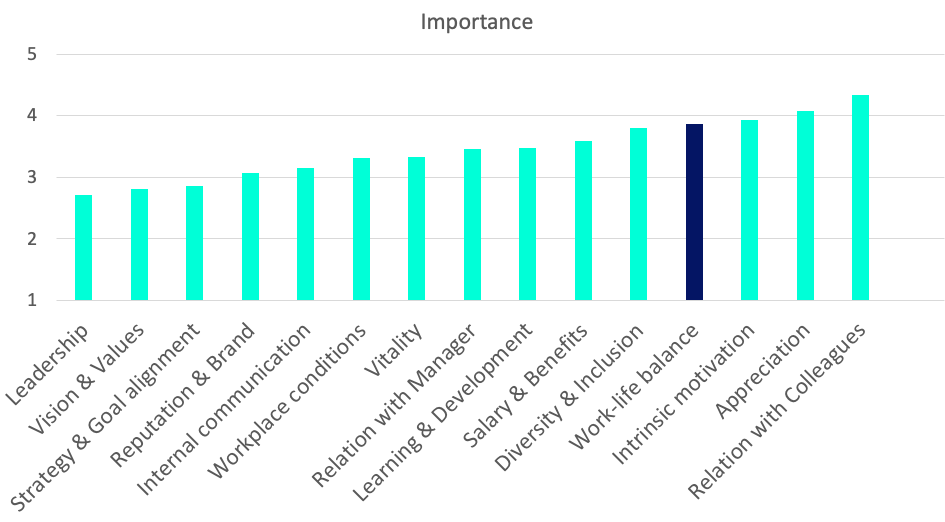Increase Employee Happiness with the four-day workweek

By 2DAYSMOODIES | 02/01/2024
An extra day off during the week sounds like a dream, but for more and more people this is becoming reality thanks to the four-day workweek. This new trend is gaining more popularity and not without reason. The four-day workweek contributes to a better work-life balance and increases employee happiness among. Research indicates that 63% of companies find it easier to attract and retain employees by offering a four-day workweek.
But what exactly does this four-day workweek entail and why is it so popular? In this blog we will tell you all about it. Two of our 2DAYSMOODIES will share their experiences with the four-day workweek. The influence of the four-day workweek on work-life balance and the influence of this on the Employee Net Promotor Score (eNPS) will also be discussed!
More employee happiness with the four-day workweek
The four-day workweek is becoming increasingly popular as it offers many benefits for both employees and employers. First of all, an extra day off ensures a better work-life balance. This can lead to less stress and better health, making employees happier and more productive at work. Creating more happiness at work with the four-day workweek. With the 2DAYSMOOD-tool you can gain insight into the mood of your employees and employee happiness in your workplace in a simple and fun way! In addition, the four-day workweek can also result in lower costs for employers, such as savings on office space and energy.
The four-day workweek, what is it?
The four-day workweek is exactly what it seems: instead of working the traditional 5 days a week, employees work 4 days a week. This may mean that employees work longer on the days they do work, for example 4 days of 9 hours. It can also mean that employees simply work fewer hours per week. In some cases, the four-day workweek is combined with working from home, giving employees even more flexibility. Our 2DAYSMOODIES Sjoerd and Esthel do the latter. In the headings below they will share their experiences with you.
Why did our 2DAYSMOODIES choose the four-day workweek?
Sjoerd: “I had a moment when I thought and asked myself: why do I actually work so much in relation to my hobbies? That is why I started working 4 days a week. Because of this decision I have 100% freedom to do all the things I want during the weekend. Also, I do not have to think on Sunday ‘oh, I have to work again tomorrow’.”
Esthel: “I opted for the four-day workweek to have enough time for personal development and also enough time for my family. My husband and I both work 4 days a week, so that we are both home with our children one day a week.”
A better work-life balance thanks to the four-day workweek
As mentioned above, the four-day workweek ensures a better work-life balance. The four-day workweek gives employees an extra day off, giving them more time for personal obligations and activities. This ensures a better work-life balance. In addition, a shorter work week can lead to improved focus and productivity during workdays. A better work-life balance results in more satisfied and more motivated employees, which leads to higher productivity and better work performance!
Employee well-being is also promoted as stress is reduced and overall life satisfaction increased. Adding up all these factors, the four-day workweek ensures more happiness at work! However, the success of a four-day workweek depends on good planning and communication, as well as effective management of workload and deadlines.
How has the four-day workweek influenced the work-life balance of our 2DAYSMOODIES?
Sjoerd: “Since I see the four-day workweek as a favor from my employer, I also provide extra quality in my work. I take it seriously. And because I’m not present for one working day during the week, I make sure that I’m very clear in my communication and I send clear updates of what I’m working on. This so that no one has to wait for me to be back at work.”
Esthel: “On my day off during the week, I can arrange all sorts of things at home. I can then be with my children and do things for myself when they are at school. The advantage of this is that I can put my full attention and energy into my work in the 4 days that I work. That leaves the weekends completely free for my family and friends and doing fun things together. It makes me a nicer person because I can spend enough time on myself, work, family and friends!”
2DAYSDATA-insights about work-life balance
Work-life balance is the balance between your work obligations and your private life. It’s about devoting enough time and energy to both your work and other important aspects of your life, such as family, friends, hobbies and relaxation. A good work-life balance ensures that you are not overloaded, that you reduce stress and that you can lead a fulfilling and healthy life. Our data analysis shows that 64% of employees is satisfied with the work-life balance within their organization. What particularly stands out from the analysis is that 78% of employees finds work-life balance very important.
Are you curious about how your organization is doing in terms of work-life balance? With the 2DAYSMOOD-tool you gain insight into this driver among your employees through quick and fun surveys
Work-life balance as an important driver of employee happiness
In collaboration with Utrecht University, we at 2DAYSMOOD have developed the Employee Happiness Model in which the 15 drivers of happiness at work are measured. After the drivers: relationship with colleagues, appreciation and intrinsic motivation, work-life balance is seen as the most important driver of employee happiness. Because of this, work-life balance is an important driver to respond to as an organization, when you want to increase happiness at work among your employees! You can do this, for example, by making use of a four-day workweek.

Increase your eNPS by paying attention to work-life balance
In addition, the employee happiness driver work-life balance also influences the eNPS of your organization. Data analysis shows that work-life balance positively influences the eNPS. This means that when employees determine to what extent they recommend your organization as a good employer, they take the work-life balance into account in their decision. Analyzes show that work-life balance explains 7% of the eNPS. This means that if you as an organization consciously improve the work-life balance, for example by using a four-day workweek, you can increase your eNPS by up to 7%!
Respond to the trend of the four-day workweek and increase employee happiness!
As an employer, you can capitalize on the popularity of the four-day workweek by looking at the needs of your employees and experimenting with different work structures. Consider, for example, a flexible working week in which employees can decide for themselves when they work, or offer working from home opportunities. In addition, it is important to be open to feedback from your employees and to work together on a working environment in which everyone can flourish.
You can collect real-time feedback from your employees using the 2DAYSMOOD-tool. Discover what is actually going on in your workplace and measure happiness at work. The 2DAYSMOOD HR experts will work with you to find the best way to use the 2DAYSMOOD-tool for the most effective possible result. In this way you know what is going on in your workplace and which points you need to respond to for a better work-life balance!